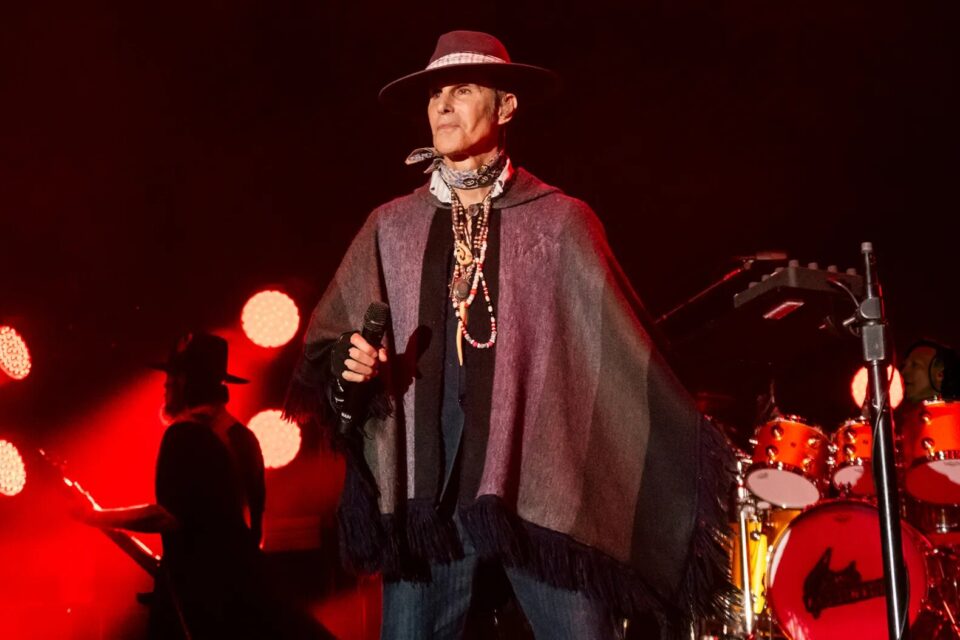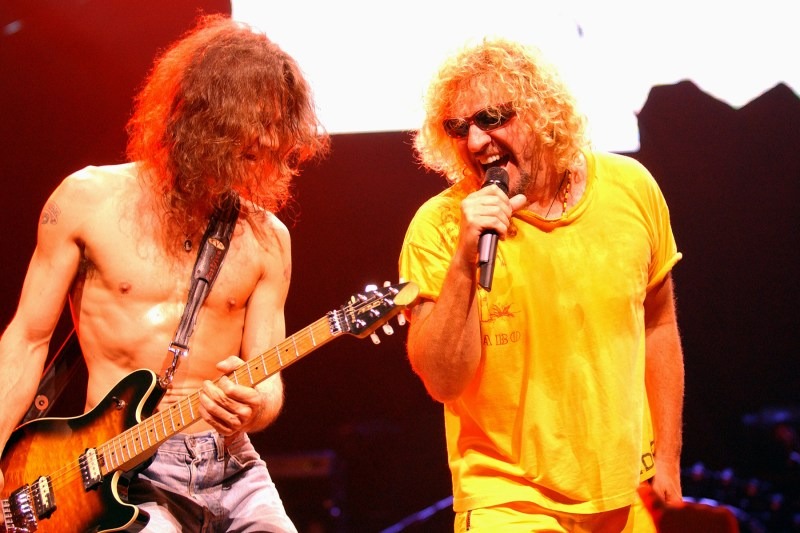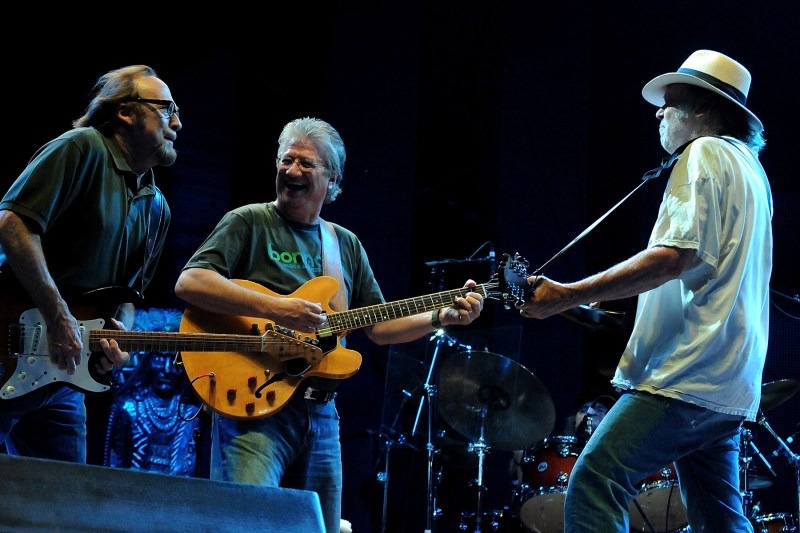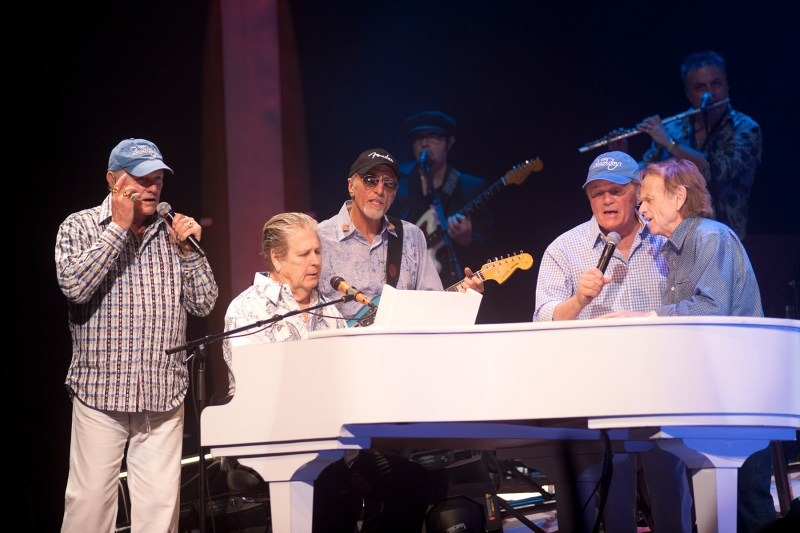Well, That Didn’t Last Long: Music’s Shortest-Lived Reunions
Jane’s Addiction’s implosion is just the latest example of a band that tried to get back together, then fell apart again

Jane’s Addiction’s performance in New York on Sept. 10 was one of their last shows before the reunion dramatically fell apart. Astrida Valigorsky/Getty Images
Jane’s Addiction imploded in remarkably ugly fashion this past week after lead singer Perry Farrell got into an onstage shoving match with guitarist Dave Navarro in Boston after a series of extremely sloppy shows that left fans concerned for the vocalist’s health. “Due to a continuing pattern of behavior and the mental health difficulties of our singer Perry Farrell, we have come to the conclusion that we have no choice but to discontinue the current US tour,” Dave Navarro, Eric Avery, and Stephen Perkins wrote in a statement. “Our concern for his personal health and safety as well as our own has left us no alternative. We hope that he will find the help he needs.”
“This weekend has been incredibly difficult and after having the time and space to reflect, it is only right that I apologize to my bandmates, especially Dave Navarro, fans, family and friends for my actions during Friday’s show,” Farrell said in response. “Unfortunately, my breaking point resulted in inexcusable behavior, and I take full accountability for how I chose to handle the situation.”
Very few reunions in rock history have ended after onstage violence between two members, but it’s hardly the first time a high-profile reformation didn’t work out. These things often fall apart due to personality conflicts that date back decades; money is another common contributing factor. Here’s a look at 11 reunions that were over almost before they started.
Jane’s Addiction

Astrida Valigorsky/Getty Images
Break-Up: The original schism took place in 1991, but they reformed in 1997, and have mostly existed in the decades that followed in various states of stability and chaos. The reunions failed to include original bassist Eric Avery until 2009, when he briefly returned to Jane’s for a tour with Nine Inch Nails, only to quit once again when it ended. He vented his frustrations in a long series of YouTube videos, which enraged guitarist Dave Navarro. “The guy’s entitled to do whatever the fuck he wants to do, and it’s fine, but keep your fuckin’ mouth shut,” Navarro said in 2013 on his online radio show Dark Matter. “I don’t wish him any harm. I have a lot of fond memories with him. But if you’re going to fuckin’ open your mouth about the inner workings and dynamics of something that has been very, very good to you for a lot of years, and then not follow through on anything else, you’ve got it coming.”
Reunion: After mending fences with Farrell, Avery came back for a world tour in 2023. But Navarro had to sit out most of those dates due to long Covid. He finally came back May 23, 2024 for the kickoff of another world tour. “We’re way stripped back on production,” Navarro told Rolling Stone in August, “and just more interested in moods and textures and drones, and having things be sonically experimental rather than, ‘Here comes the dog-barking song.’ We seem to have found a depth within ourselves that we weren’t maybe able to reach in our younger years.”
Duration: Four months. Things were pretty good throughout the European run in May, June, and July 2024, but Farrell was clearly struggling during some of the American shows in August and September. At a New York City show at Pier 17 on Sept. 10, he spoke semi-incoherently to the crowd throughout the night, and nearly stopped the show after “Jane Says” because his voice was failing. They managed to limp through the rest of the set. Three days later, the Boston show ended in fisticuffs.
Led Zeppelin

rune hellestad/Corbis/Getty Images
Break-Up: Zeppelin dissolved immediately after the death of drummer John Bonham on Sept. 25, 1980. They could have copied the playbook from the Who a couple of years earlier and simply carried on with a different drummer, but Robert Plant had no interest.
Reunion: The surviving members reformed for a handful of events over the years — Live Aid in 1985, the Atlantic Records 40th anniversary concert in 1988, Jason Bonham’s wedding in 1990, and their Rock and Roll Hall of Fame induction in 1995. But these were all just a few songs each. There wasn’t a full show until Dec. 10, 2007, when they headlined a tribute to Ahmet Ertegun at the O2 Arena in London.
Duration: Two hours and four minutes. The O2 show was a triumph on every possible level, and there were very lucrative offers on the table for a world tour. But Raising Sand, Plant’s collaborative album with Alison Krauss, was starting to sell by the millions at this exact point in time. This was very good for his solo career and Grammy collection, and very bad for Led Zeppelin. Jimmy Page and John Paul Jones briefly considered touring with a replacement vocalist like Steven Tyler or Myles Kennedy, but they came to their senses and just ended the whole thing. And Robert Plant has shot down any talk of further Zeppelin shows since then. “A tour would have been an absolute menagerie of vested interests and the very essence of everything that’s shitty about big-time stadium rock,” he told Rolling Stone in 2014. “We were surrounded by a circus of people that would have had our souls on the fire. I’m not part of a jukebox!”
Journey and Steve Perry

Jeffrey Mayer/WireImage
Break-Up: Journey split in 1987 because Steve Perry wanted to take an indefinite break from the music industry. “I went back to my hometown and reconnected with old friends,” he told Rolling Stone in 2018. “I bought a Harley Davidson and rode it around the country roads of my youth. I let the wind hit my face and my hair blowed behind me. There were no helmet laws back then. I disappeared. I went to the fair in the summer. I went to movies. I had dinner with friends. I had relationships. I lived.” Money wasn’t an issue for him. “I was probably one of the only guys who saved his money,” he said. “A lot of people were living very extravagant lifestyles. I was not raised that way. My grandfather said to me when I was very young, ‘It’s not how much you make, it’s how much you save.’ So I lived small and saved my money.”
Reunion: Perry got the itch to return to Journey in 1996, and the Escape-era lineup reformed to cut Trial By Fire. It generated the hit “When You Love a Woman,” which was nominated for a Grammy. Journey’s new manager was putting together a massive reunion tour, just two years after he masterminded Hell Freezes Over for the Eagles.
Duration: Just about a year, and they never played a single show together. Everything unraveled when Perry came down with a degenerative bone condition that required hip surgery. The others grew very frustrated when he held back on booking a date for the procedure. “I didn’t feel it was a group decision,” Perry told Rolling Stone. “Then I was told on the phone that they needed to know when I was gonna do it ’cause they had checked out some new singers.” Despite his pleas, they carried on with replacement vocalist Steve Augeri (and later with his replacement, Arnel Pineda). Perry never sang with them again.
Van Halen and Sammy Hagar

SGranitz/WireImage
Break-Up: Believe it or not, tension surrounding the Twister soundtrack caused Sammy Hagar to leave Van Halen in 1995. The group had just finished a long world tour, and Hagar was exhausted and angry when they worked on a song for the movie. They couldn’t agree on the lyrics, and the bitterness grew and grew. “I was fired,” Hagar told Rolling Stone in 2022. “I was told that I quit by Eddie. It was Father’s Day, Sunday morning, 9 a.m. The phone rings and I’m laying there with my brand new baby. He goes, ‘You know, you always just wanted to be a solo artist, so go ahead and be one. We’re going to get Dave back in the band.’ And when he said that, I flew up out of bed like I’d seen a ghost. And I said, ‘Wow’ and a few expletives went back and forth from me.”
Reunion: The reunion with Dave flamed out with remarkable speed due to his antics at the 1996 MTV Video Music Awards, and the band was already working with Extreme singer Gary Cherone by that time. But their lone album and tour with Cherone were major commercial disappointments, and they invited Hagar back for a tour in 2004. It kicked off June 11 of that year in Greensboro, North Carolina. From the very beginning, it was a nightmare for Hagar because Eddie Van Halen was drinking heavily. “He was so out of tune and playing the songs so wrong that there were times I couldn’t sing well,” Hagar said. “I had a hard time staying on key. I’d go over and I would sing with the bass because Mike would always be in tune. I’d sing to the bass.”
Duration: Five months. They somehow managed to play 80 shows between June and November 2004, but Eddie and Alex Van Halen were barely on speaking terms with Hagar and bassist Michael Anthony for the duration of it. When it finally wrapped, they went their separate ways and never spoke in person again. Only at the very end of Eddie’s life did he reestablish contact with Hagar via a series of telephone calls where they finally patched things up. Eddie died before they could meet up in person.
Diana Ross and the Supremes

Paul Drinkwater/NBCU Photo Bank/NBCUniversal/Getty Images
Break-Up: Nothing was ever the same for the Supremes after Florence Ballard was fired from the group in 1967. They re-dubbed themselves Diana Ross and the Supremes after they recruited Cindy Birdsong to replace Ballard. Unsurprisingly, this new name didn’t sit well with original member Mary Wilson. But the group carried on until 1970, when Ross left to launch a successful solo career. Wilson and Birdsong soldiered on with a series of replacement singers until 1977, when they too called it quits.
Reunion: Ballard died in 1976, but the trio of Ross, Wilson, and Birdsong reunited for a very tense performance of “Someday We’ll Be Together” at the 1983 Motown 25th anniversary concert. When reunion tours became very lucrative in the 1990s, promoters put together an offer for a Supremes tour that Diana Ross accepted. Arenas all over America were booked for the summer of 2000. They called it the Return to Love Tour.
Duration: Zero seconds. According to multiple reports, Ross was offered $15 million for the tour. Wilson was lowballed at $2 million, and Birdsong was offered just half of that. Thinking it was the starting point of a negotiation, Wilson and Birdsong rejected the offer. The promoters responded by offering their positions to latter-day Supremes Scherrie Payne and Lynda Laurence, despite the fact they’d never before worked with Ross. This resulted in an avalanche of negative press that ended the tour after just 13 shows. Ross, Wilson, and Birdsong never took the stage together.
Cream

Kevin Mazur/WireImage
Break-Up: Jack Bruce and Ginger Baker hated each other before Cream even played a note of music together. But they were the best bassist and drummer on the London blues rock scene, and Clapton wanted to work with the “cream” of that crop. The result was two years of amazing records and concerts, but almost constant fighting. Clapton says what inspired him to break up the band, however, was a negative review in Rolling Stone, written by Jon Landau. “All during Cream I was riding high on the ‘Clapton Is God’ myth that had been started up,” he told RS in 1985. “Then we got our first bad review, which funnily enough, was in Rolling Stone. The magazine ran an interview with us in which we were really praising ourselves, and it was followed by a review that said how boring and repetitious our performance had been. And it was true! The ring of truth just knocked me backward; I was in a restaurant and I fainted. After I woke up, I immediately decided that it was the end of the band.”
Reunion: They played a few songs at their 1993 Rock and Roll Hall of Fame induction ceremony, but didn’t actually do any gigs until 2005, when they announced a four-night stand at London’s Royal Albert Hall. They followed it up later in the year with three shows at Madison Square Garden in New York. Jack Bruce was recovering from liver cancer at the time, and Clapton promised him they’d do more shows if his health improved. They didn’t quite sound like they did back in 1968, but the shows were still rapturously received. Nobody thought they’d ever see those three men play in public together again.
Duration: Five months. Old tensions between Bruce and Baker resurfaced at Madison Square Garden, and Clapton was once again stuck between them. This time around, they were fighting about sound levels on the stage. “In many ways, I wish we had left it at the Royal Albert Hall,” Clapton wrote in his memoir. “But the offer was too good to refuse. My heart had gone out of it, and also a certain amount of animosity had crept back in.” They never played again.
Outkast

Tim Mosenfelder/Getty Images
Break-Up: It’s rarely a good sign when groups release new albums that are essentially solo discs cobbled together. That happened in 2003 when Outkast dropped Speakerboxxx/The Love Below. It was a clear indication that Big Boi and André 3000 had differing visions for the group, and were no longer creatively compatible. But the album was a giant hit thanks to “Hey Ya,” and they came back together once again in 2006 to create the soundtrack to their movie Idlewild. They split shortly after the movie left theaters, and this time the album didn’t generate any sort of hit.
Reunion: After nearly a decade in which it seemed all but impossible, Outkast reformed in 2014 for a tour of summer festivals. They played all the classics, including “Ms. Jackson” and “Rosa Parks,” in addition to doing brief solo sets. But it felt like this tour was more about money than art, especially since they didn’t do any headlining dates outside of festivals. They did, however, agree to play a private show at Terminal 5 for the Cartoon Network.
Duration: Six months. That’s how long it took Outkast to hit just about every major festival in Europe and America, play a handful of corporate dates, and walk away with an astoundingly large check. Big Boi resumed his solo career in the aftermath, and André 3000 largely walked away from music until late 2023, when he released New Blue Sun, an instrumental flute record. He’s in the middle of a tour supporting it. But if you’re showing up hoping to hear “Hey Ya,” it might be wiser to stay home. It’s not that kind of tour.
Buffalo Springfield

Jeff Kravitz/FilmMagic
Break-Up: The entire saga of Buffalo Springfield took place across a scant two years between 1966 and 1968. They cut three albums in that time, played a ton of shows (almost none of which were recorded), and went through an absurd amount of lineup changes. That’s partially because bassist Bruce Palmer, born in Canada, was dealing with significant immigration issues at the time, but the larger issue was Neil Young’s almost complete inability to handle the compromises required when you’re in a band. He quit three different times. In May 1968, the band dissolved after a farewell concert in Long Beach, California.
Reunion: The group privately reunited a couple of times in the mid-1980s, but didn’t play in public until the 2010 Bridge School Benefit. By that time, Palmer and drummer Dewey Martin were both dead. The core lineup of Young, Stephen Stills, and Richie Furay played a wonderful acoustic set that inspired them to announce a brief California club tour and a headlining slot at Bonnaroo 2011. Plans were in place for a much larger tour to follow, including a stop at Red Rocks.
Duration: Nine concerts across seven months. After the Bonnaroo show, history repeated itself when Young walked away from the band yet again, and opted to tour with Crazy Horse instead. “I’d be on a tour of my past for the rest of fucking time,” Young told Rolling Stone. “I have to be able to move forward. I can’t be relegated. I did enough of it for right then.” Stills wasn’t thrilled. “We were supposed to work for most of the summer,” he said. “It left me in a lurch for three quarters and ruined my financial planning. Also, 150 people got laid off that were supposed to work on the tour.”
The Beach Boys

Paul Natkin/WireImage
Break-Up: The Beach Boys never actually broke up. They just slowly shed original members due to deaths, mental illness, and personality conflicts. By 1998, the touring unit consisted solely of Mike Love, mid-Sixties replacement member Bruce Johnston, and other non-original members. Brian Wilson and Al Jardine toured under their own names, eventually joining forces in 2006. There was much bad blood between the two camps, especially after Love sued Wilson over a promotional Smile record in 2005 that used imagery of the entire band.
Reunion: Both sides agreed to put their differences aside in 2012 to celebrate their 50th anniversary with a new Beach Boys album and a world tour. It took about as much negotiation as the 1945 Yalta Conference, but they eventually agreed to merge the two bands and craft a setlist that celebrated their entire history, with a strong emphasis on their Sixties hits. Special moments were carved out in the set every night to celebrate the late Dennis and Carl Wilson.
Duration: Five months. They managed to play 50 shows between April and September of 2012 before Mike Love told the press it was over. Brian responded by saying he was caught off-guard by the announcement. “I did not fire Brian Wilson from the Beach Boys,” Love told the L.A. Times. “I cannot fire Brian Wilson from the Beach Boys. I am not his employer. I do not have such authority. And even if I did, I would never fire Brian Wilson from the Beach Boys. I love Brian Wilson. We are partners. He’s my cousin by birth and my brother in music.” They’ve appeared together at a handful of public events in the 12 years since the reunion tour, but they never again played together. And now that Wilson is suffering from dementia and no longer doing solo shows, any sort of reunion is impossible.
The Velvet Underground

Leon Morris/Redferns/Getty Images
Break-Up: Despite their enormous impact on the music world, the Velvet Underground were not a commercially successful group. They started to splinter in 1968, when Lou Reed fired co-founder John Cale after their LP White Light/White Heat peaked at 199 on the Billboard 200. Cale was replaced by Doug Yule and the group went in a considerably more commercial direction on 1969’s The Velvet Underground and 1970’s Loaded, but they remained largely an underground act. Reed left the band before Loaded hit stores. There was one more LP, 1973’s Squeeze, but it’s a Doug Yule solo album in everything but name.
Reunion: Cale and Reed reconnected at Andy Warhol’s funeral in 1987, and eventually made plans to honor their late mentor with the 1990 collaborative album Songs for Drella. The next step was to bring drummer Maureen Tucker and guitarist Sterling Morrison back into the fold and actually reunite the band. They toured Europe in 1993 and played a set packed with Velvet Underground classics, including songs they released after Cale left the band. It’s documented on the album Live MCMXCIII.
Duration: Two months. They managed to get through the European tour largely without incident, but an American leg and MTV Unplugged special were scuttled when Reed and Cale started to fight again. They didn’t get along very well in 1967. It’s no huge surprise they couldn’t make it work again in 1993. They did come together once more when they were inducted into the Rock and Roll Hall of Fame in 1996, but it was a one-off.
Jefferson Airplane

Chris Walter/WireImage
Break-Up: The story of how Jefferson Airplane turned into Jefferson Starship and then simply Starship across a two-decade period is enormously long and complicated. To cut to the end, Starship — featuring Grace Slick on lead vocals — scored giant Eighties hits with craptacular songs like “We Built This City” and “Sara.” They’d never been more popular as a commercial force, but Slick hated the music. She quit in 1988, leaving Starship without a single member from Jefferson Airplane’s classic era.
Reunion: Slick quit Starship so she could get back to her roots with a reformed Jefferson Airplane. They cut a self-titled album in 1989, which received uniformly negative reviews, and hit the oldies circuit. The set didn’t feature a single Starship hit, so anyone who showed up hoping to hear “We Built This City” left very unhappy. But they did hear Hot Tuna tunes, and a few Jefferson Starship songs like “Miracles.”
Duration: A little over two months. Once Slick completed her obligations to the reunion tour, she reassessed her life. The thought of singing “White Rabbit” and “Somebody to Love” over and over as she grew older and older didn’t appeal to her. Despite all the financial rewards she would have received had she stayed in Jefferson Airplane and continued to tour, she decided to dissolve the band and walk away from music. “All rock-and-rollers over the age of 50 look stupid and should retire,” she told VH1’s Behind the Music in 1998. There are now competing groups billing themselves as Starship and Jefferson Starship. But there’s no Jefferson Airplane. That name ended when Slick retired back in 1989.
From Rolling Stone US.







